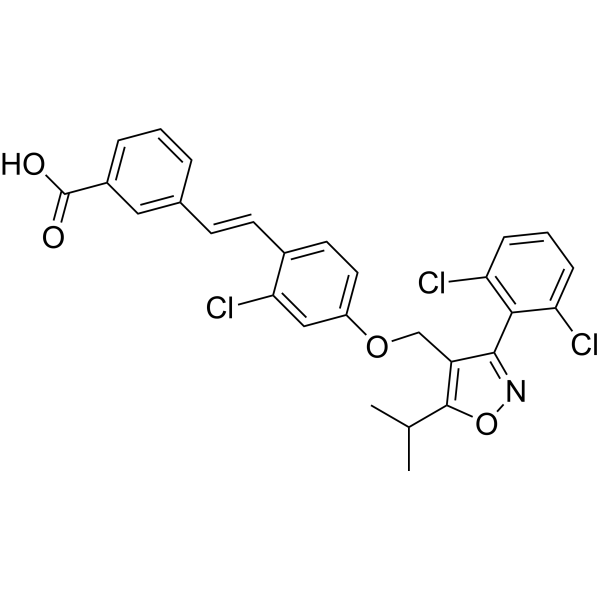Home
Products
GW4064



| Product Name | GW4064 |
| Price: | Inquiry |
| Catalog No.: | CN00118 |
| CAS No.: | 278779-30-9 |
| Molecular Formula: | C28H22Cl3NO4 |
| Molecular Weight: | 542.84 g/mol |
| Purity: | >=98% |
| Type of Compound: | Alkaloids |
| Physical Desc.: | Powder |
| Source: | |
| Solvent: | Chloroform, Dichloromethane, Ethyl Acetate, DMSO, Acetone, etc. |
| SMILES: | Clc1cc(ccc1C=Cc1cccc(c1)C(=O)O)OCc1c(onc1c1c(Cl)cccc1Cl)C(C)C |
| Contact us | |
|---|---|
| First Name: | |
| Last Name: | |
| E-mail: | |
| Question: | |
| Description | GW 4064 is a potent FXR agonist with EC50 of 65 nM. |
| Target | EC50: 65 nM (FXR)[1] |
| In Vitro | Treatment with different concentrations of GW4064 (1, 2.5, 5, 10 μM) reduces the lipid accumulation in the cells. Concordantly, GW4064 treatment significantly represses oleic acid-induced CD36 protein levels in a dose-dependent manner. Taken together, these data indicate that prevention of hepatic lipid accumulation is likely due to an inhibition of Cd36 expression by long-term GW4064 treatment[2]. |
| In Vivo | GW4064 suppresses weight gain in C57BL/6 mice fed with either a high-fat diet (HFD) or high-fat, high-cholesterol diet. GW4064 treatment of mice on HFD significantly represses diet-induced hepatic steatosis as evidenced by lower triglyceride and free fatty acid level in the liver. GW4064 markedly reduces lipid transporter CD36 expression without affecting expression of genes that are directly involved in lipogenesis. GW4064 treatment attenuates hepatic inflammation while having no effect on white adipose tissue[2]. GW4064 (30 mg/kg) treatment results in substantial, statistically significant reductions in serum activities of ALT, AST, LDH, and ALP in the ANIT-treated rats. Serum bile acid levels are also significantly reduced by GW4064 treatment. Bilirubin levels are decreased in the GW4064-treated rats, but statistical significance is not achieved. Notably, GW4064 is much more effective in decreasing these markers of liver damage than TUDCA, which reduces only LDH levels[3]. |
| Cell Assay | Mouse liver cells (BNL CL.2) are maintained in a humidified incubator under 5% CO2 at 37°C in Dulbecco's Modified Eagle's Medium (DMEM) supplemented with 10% fetal bovine serum (FBS) and 1% Penicillin/Streptomycin. When cells are divided into six-well plates and reach ~90% confluence, sub-confluent cells are washed three times with phosphate buffered saline (PBS) and replaced with serum-free DMEM supplemented with 1% fatty acid-free BSA. Oleic acid (final concentration 500 μM) and GW4064 at various concentrations are added and incubated for 24 h. Cells are then fixed with 4% formaldehyde for Oil Red O staining or harvested for protein and western blot analysis[2]. |
| Animal Admin | Mice[2] Fifteen-week-old male C57BL/6 mice are fed a high-fat diet with or without additional 0.2% Cholesterol and received twice weekly injections of GW 4064 (50 mg/kg, intra-peritoneal) or carrier solution (DMSO) solution for 6 weeks. Animals are weighed weekly and their body composition is determined using EchoMRI-100TM from Echo Medical Systems. Rats[3] Animals. Adult male CRL:CD(SD)IGS rats weighing 300-350 g, are used. The rats receive a single analgesic dose of oxymorphone following surgery. Twenty-four hours after laparotomy, groups of rats (n=6) receive intraperitoneal injections once daily for 4 days. Bile duct-ligated (BDL) rats are treated with 5 mL/kg corn oil as vehicle, 30 mg/kg GW4064 in corn oil, or 15 mg/kg TUDCA in corn oil. Sham-operated animals received 5 mL/kg corn oil vehicle. Four hours after the final dose, serum and livers are collected for analysis. |
| Density | 1.4±0.1 g/cm3 |
| Boiling Point | 702.1±60.0 °C at 760 mmHg |
| Flash Point | 378.4±32.9 °C |
| Exact Mass | 541.061462 |
| PSA | 72.56000 |
| LogP | 8.49 |
| Vapour Pressure | 0.0±2.3 mmHg at 25°C |
| Storage condition | -20℃ |